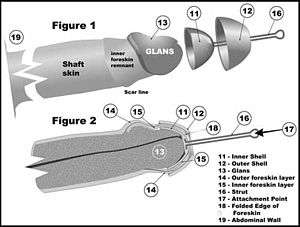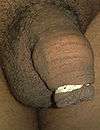Restoration device
A restoration device is a device used for applying tension to skin during the process of non-surgical foreskin restoration.[1] Those who use such a device employ the technique of tissue expansion, which causes new skin to grow.

History
Until the 2nd century AD, the Pondus Judaeus was used among some circumcised males. It was a replacement for more painful techniques known at the time. This device was a bronze sheath used to expand the foreskin, which at the time was not fully excised. Its effectiveness became limited after circumcisions were modified to eliminate its use (Tushmet 1965).[2]
During the late 20th century and early 21st century, new techniques were developed to suit the needs of men circumcised by physicians in North America. These circumcisions often left little movable skin on the penile shaft, and this was taken into consideration by developers of restoration techniques. Some devices have been designed to require little skin to be usable. During the 1990s, the process of foreskin restoration employed adhesive tape, such as tapes used in hospitals or for athletics, to pull skin forward or attach weights and pulling devices to provide tension.[1] One device composed entirely of tape is called T-Tape, named for its cross-sectional shape.[3]
Function
.jpg)
The following steps describe the application of a typical tapeless device:[4]
- a device, such as cone or plastic shell, is placed over the glans
- skin is then pulled onto the device
- the skin is covered with a flexible gripping cap
- tension is applied by pulling the device
The following steps describe the application of a typical device in which tape is needed:[5]
- a device, such as a cone, bell or shell, is placed over the glans
- skin is pulled onto the device
- then tape is applied to keep the skin in place
- the device is then pulled using a rubber band or has a weight with it to apply tension .
Modern devices
Older methods have been partially replaced by the use of various plastic or silicone components. The entire design and function of the “modern” devices was first described in the 2003 Foreskin Restoration Device patent by the inventor of the Tug Ahoy. Many new devices grip the skin, usually without the use of tape. Some devices are homemade, often designed by men whose skin is easily irritated by adhesive tapes. Also, the tapeless devices can be applied and removed in seconds (with practice), and — unlike "T-tape" — don't require getting an erection before they are applied. There are several different varieties of tapeless restoration devices commercially available.
Most devices are equipped with an elastic band or some type of tension adjustment to pull the skin away from the glans. As the tension is applied, the natural process of mitosis is stimulated.
Some restoration devices are more comfortable or more effective than others. In some cases where there is too little skin to pull onto the gripping surface, pressure must be applied to the glans when applying the device. Most devices and weights are easily washed and can be reused each day.
Tape-less devices
Dual Tension Restorer (DTR)
_applied.jpg)
Dual Tension Restorer (DTR) can be used either as a bi-directional restoration device or as a tugger. It is a simple device which is very easy to use and easy to clean. It is almost entirely made up of nylon. It consists of a pusher plate attached to shaft on which the nylon bell can move freely. The bell is also fitted with a tension holding screw by which the bell can be fixed in place. There is a silicone gripper which holds the foreskin in place. The bell also has two nylon screws by which rubber bands are held in place which is passed through the shaft. The rubber band provides the required tension. The shaft with the pusher plate can be removed and replaced by a rod with a ring with hook in this arrangement it can be used as a tugger. DTR has two kinds of grippers; one is simple and the other has holes which provides a good hold on the foreskin. The tension on the foreskin by DTR depends mainly on the size of the shaft rod and the size & strength of the rubber band.
TLC Tugger and TLC-X
The TLC Tugger consists of two cones made of soft food-grade silicone. One is placed over the glans and the foreskin is moved over that cone and other cone is placed over the skin to secure it in place, the inner cone has a handle to which elastic straps or weights can be attached to provide tension. TLC-X has a pusher inside the cones to provide bi-directional tension and a rod for attaching weights or rubber bands for strapless tension. These devices are provided custom-sized for every user, based on supplied glans-width measurements in the flaccid and erect states.
Myskinclamp
It is made of stainless steel pusher cone with spring which pushes the other steel cone which can slide on the pusher shaft and a plastic cone to hold the foreskin in place. It also has an option for a strap by which it is tied with the leg or can be used as a tugger.
DILE Insert ( Tape-less )
It has an oval ball divided into two parts (hemisphere) the lower part is attached to the shaft and is fixed and acts as a pusher and the upper part moves on the shaft which has threads like a screw . It is inserted in the foreskin and the skin moved on to the upper part and held in place by the silicone gripper .And the device is expanded by twisting the shaft which moves the upper part to provide the tension .
CAT II Q
The CAT II Q was one of the first "non tape" bi-directional restoration devices. It consists of a shaft (tension rod) with a pusher plate and a bell with a silicone gripper, the bell can move on the shaft and has a collet to hold it in place. The collet easily slides up the tension rod, staying where it is placed, until being manually re-positioned for more or less tension. The skin is placed over the bell and silicone gripper is applied to hold it in place, the bell is moved to desired position to provide the tension and then the collet is fixed to hold the bell at that position.
In addition to the CAT II Q standard configuration, a "Deep Pusher" is available to relieve pressure from the glans and improve the efficiency of the tension . A fair amount of skin would be needed to use the Deep Pusher. Also, base rings are available to assist in retaining the scrotal and pubic skin from being stretched along the shaft, once again improving the efficiency.
Tape devices

Supercanister
A precision machined device from food grade Dupont Delrin engineered polymer, with a stainless steel wire bail. The device is applied with tape, and an elastic strap is attached to the bail for tugging. Through hole permits easy urination without removal of device.
Foreballs
It is designed having two ball bearings joined with a small rod. The size of the bearings is different too, as one is small and one is larger. It's a simple device and is easy to use. The foreskin is pulled over one of the bearings and tape is applied to keep it in place, while the other bearing acts as a weight and applies tension.
Penile Uncircumcising Device (PUD)
It is a funnel-shaped stainless steel chamber which is worn over inside the foreskin and held in place with the help of tape, the weight of the device itself is the source of tension needed.
Foreskin Natural Restorer
The device is made of stainless steel bell which can slide on a shaft and has a screw to hold the tension. The skin is placed over the bell and tape is applied to hold it in place then the bell is moved into the place to apply the tension needed .
DILE Insert ( Tape )
It has a pusher which is attached to the shaft, the shaft is made like a screw, and a crown which can move on the shaft. A modified type of T-Tape which has holes is applied to the foreskin on the POE . Then the holes are placed on the crown, and the shaft is turned to move the crown to provide the tension

Retainer
The function of a foreskin retainer is to keep the glans penis covered by the available foreskin. A foreskin retainer can be used when newly grown foreskin is neither long enough nor tight enough to keep the glans covered itself, but is long enough that it can be stretched past the glans (which is necessary to facilitate the use of a retainer). Rubber bands, o-rings, Band-Aids, and cones with both ends open can be used as retainers.
The foreskin can also be retained with a medical adhesive, known as MRS. MRS is a silicone based skin safe adhesive. MRS originally stood for Miracle Restoration Spray, but is now available in a brushable form. A small amount of adhesive is applied to the glans, and the skin is rolled up and retained by the MRS. MRS sets up almost instantly, but the skin can still be pulled back if necessary.
See also
References
- 1 2 Bigelow, Jim (1992). The Joy of Uncircumcising!: Exploring Circumcision: History, Myths, Psychology, Restoration, Sexual Pleasure, and Human Rights. Aptos, CA: Hourglass Book Publishing. ISBN 978-0-9630482-1-9.
- ↑ Archived February 15, 2002, at the Wayback Machine.
- ↑ Restoringmen.net Archived February 25, 2012, at the Wayback Machine.
- ↑ "US Patent No. 6,579,227"., issued June 17, 2003, Foreskin restoration device, by James A. Haughey
- ↑ "US Patent No. 5,344,396"., issued September 6, 1994, Device for stretching the foreskin of the penis, by Roland T. Clark, Jr.
External links
Tapeless devices
Devices requiring tape
- Foreskin Natural Restorer
- Foreballs
- The PUD (Penile Uncircumcising Device)
- DILE Insert
- Supercanister - MRS